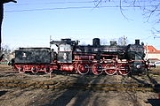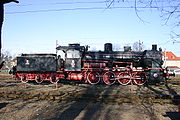
Prussian G 8
Encyclopedia
The Prussian Class G 8 locomotives were eight-coupled, superheated, freight locomotives operated by the Prussian state railways
. There were two variants: the G 8 built from 1902 with a 14 tonne axle load
and the "reinforced G 8" (verstärkte G 8) built from 1913 (later designated the G 8.1
) with a 17 tonne axle load. The latter was the most numerous German state railway (Länderbahn) locomotive, over 5,000 examples being built.
, which is why it initially suffered from a host of teething troubles. One further problem was the restriction to a 14 tonne axle load; as a result many components had to be made too light in order to save weight. During its period of procurement constant modifications were made to the locomotives: the cylinder bore was increased from 575 to 600 mm; and the grate area, evaporative heating area and superheater area were also increased in size.
Seven engines were experimentally fitted with Stumpf parallel flow cylinders (Gleichstrom-Zylindern). Ten more were given Lenz valve gear. Neither of these variants improved on the standard design however.
 After the First World War, 336 locomotives had to be given to Germany's former enemies as reparations
After the First World War, 336 locomotives had to be given to Germany's former enemies as reparations
and 18 units to the Saar Railway. In 1925 the Deutsche Reichsbahn
took over 656 locomotives as Class 55.16-22, numbering them as 55 1601-2256 in their renumbering plan
. In 1935 they were joined by another twelve were from the Saarbahn, nos. 55 2257-2268. In the Second World War several more came from Poland
and were given the numbers of already retired engines between 55 1604 and 55 1710.
After the war the DB
ended up with 205 examples, and the DR 50. In the GDR the last one was retired in 1969, whereas the DB had retired them by 1955.
After the Second World War, locomotives 55 1681, 1881 and 2180 were left in Austria
. No. 55 1881 was returned to the DB in 1950. The two remaining engines formed ÖBB Class 755 in the ÖBB keeping their serial numbers. Number 755.2180 was retired in 1954, and 755.1681 not until 1957.
Locomotive Nr. 4981 Mainz (see picture in the infobox) is in working condition. Built in 1913 by Hanomag as No. 6721 and in service with the Prussian state railways
as 4981 Münster, it sent was to work in 1916, along with 24 others, on the construction of the Baghdad Railway
(Bagdadbahn) in Turkey
, where she was given Turkish Railways number 44 079. In 1987, the still operational locomotive was purchased by German railway fans, to be hauled across Bulgaria, Yugoslavia and Austria to Germany and restored by the Darmstadt-Kranichstein Railway Museum
. The journey, which had cost 47,000 deutschmarks of which 36,531 DM were invoiced by Deutsche Bahn
for the leg in Germany, is documented in a book.
The locomotives were equipped with Prussian tenders of classes pr 3 T 12, pr 3 T 16.5 and pr 2'2' T 16.
Prussian state railways
The term Prussian state railways encompasses those railway organisations that were owned or managed by the State of Prussia...
. There were two variants: the G 8 built from 1902 with a 14 tonne axle load
Axle load
The axle load of a wheeled vehicle is the total weight felt by the roadway for all wheels connected to a given axle. Viewed another way, it is the fraction of total vehicle weight resting on a given axle...
and the "reinforced G 8" (verstärkte G 8) built from 1913 (later designated the G 8.1
Prussian G 8.1
The Prussian G 8.1 was a heavier, stronger development of the G 8 and was initially referred to as a 'strengthened standard class' .- History :...
) with a 17 tonne axle load. The latter was the most numerous German state railway (Länderbahn) locomotive, over 5,000 examples being built.
History
A total of 1,054 Prussian G 8 locomotives were built between 1902 and 1913 by various manufacturers. It was the first superheated goods train locomotive in PrussiaKingdom of Prussia
The Kingdom of Prussia was a German kingdom from 1701 to 1918. Until the defeat of Germany in World War I, it comprised almost two-thirds of the area of the German Empire...
, which is why it initially suffered from a host of teething troubles. One further problem was the restriction to a 14 tonne axle load; as a result many components had to be made too light in order to save weight. During its period of procurement constant modifications were made to the locomotives: the cylinder bore was increased from 575 to 600 mm; and the grate area, evaporative heating area and superheater area were also increased in size.
Seven engines were experimentally fitted with Stumpf parallel flow cylinders (Gleichstrom-Zylindern). Ten more were given Lenz valve gear. Neither of these variants improved on the standard design however.

World War I reparations
World War I reparations refers to the payments and transfers of property and equipment that Germany was forced to make under the Treaty of Versailles following its defeat during World War I...
and 18 units to the Saar Railway. In 1925 the Deutsche Reichsbahn
Deutsche Reichsbahn
Deutsche Reichsbahn was the name of the following two companies:* Deutsche Reichsbahn, the German Imperial Railways during the Weimar Republic, the Third Reich and the immediate aftermath...
took over 656 locomotives as Class 55.16-22, numbering them as 55 1601-2256 in their renumbering plan
DRG renumbering plan for steam locomotives
In 1922 the Deutsche Reichsbahn began to develop a renumbering plan to standardize the numbering of steam locomotives that had been taken over from the state railways . Its basis was the corresponding DRG classification system....
. In 1935 they were joined by another twelve were from the Saarbahn, nos. 55 2257-2268. In the Second World War several more came from Poland
Poland
Poland , officially the Republic of Poland , is a country in Central Europe bordered by Germany to the west; the Czech Republic and Slovakia to the south; Ukraine, Belarus and Lithuania to the east; and the Baltic Sea and Kaliningrad Oblast, a Russian exclave, to the north...
and were given the numbers of already retired engines between 55 1604 and 55 1710.
After the war the DB
Deutsche Bundesbahn
The Deutsche Bundesbahn or DB was formed as the state railway of the newly established Federal Republic of Germany on September 7, 1949 as a successor of the Deutsche Reichsbahn-Gesellschaft '...
ended up with 205 examples, and the DR 50. In the GDR the last one was retired in 1969, whereas the DB had retired them by 1955.
After the Second World War, locomotives 55 1681, 1881 and 2180 were left in Austria
Austria
Austria , officially the Republic of Austria , is a landlocked country of roughly 8.4 million people in Central Europe. It is bordered by the Czech Republic and Germany to the north, Slovakia and Hungary to the east, Slovenia and Italy to the south, and Switzerland and Liechtenstein to the...
. No. 55 1881 was returned to the DB in 1950. The two remaining engines formed ÖBB Class 755 in the ÖBB keeping their serial numbers. Number 755.2180 was retired in 1954, and 755.1681 not until 1957.
Locomotive Nr. 4981 Mainz (see picture in the infobox) is in working condition. Built in 1913 by Hanomag as No. 6721 and in service with the Prussian state railways
Prussian state railways
The term Prussian state railways encompasses those railway organisations that were owned or managed by the State of Prussia...
as 4981 Münster, it sent was to work in 1916, along with 24 others, on the construction of the Baghdad Railway
Baghdad Railway
The Baghdad Railway , was built from 1903 to 1940 to connect Berlin with the Ottoman Empire city of Baghdad with a line through modern-day Turkey, Syria, and Iraq....
(Bagdadbahn) in Turkey
Turkey
Turkey , known officially as the Republic of Turkey , is a Eurasian country located in Western Asia and in East Thrace in Southeastern Europe...
, where she was given Turkish Railways number 44 079. In 1987, the still operational locomotive was purchased by German railway fans, to be hauled across Bulgaria, Yugoslavia and Austria to Germany and restored by the Darmstadt-Kranichstein Railway Museum
Darmstadt-Kranichstein Railway Museum
The Darmstadt-Kranichstein Railway Museum a railway museum in the German city of Darmstadt. It is also the largest railway museum in the state of Hesse....
. The journey, which had cost 47,000 deutschmarks of which 36,531 DM were invoiced by Deutsche Bahn
Deutsche Bahn
Deutsche Bahn AG is the German national railway company, a private joint stock company . Headquartered in Berlin, it came into existence in 1994 as the successor to the former state railways of Germany, the Deutsche Bundesbahn of West Germany and the Deutsche Reichsbahn of East Germany...
for the leg in Germany, is documented in a book.
The locomotives were equipped with Prussian tenders of classes pr 3 T 12, pr 3 T 16.5 and pr 2'2' T 16.
External links
- There is a relevant English-language forum at Railways of Germany

